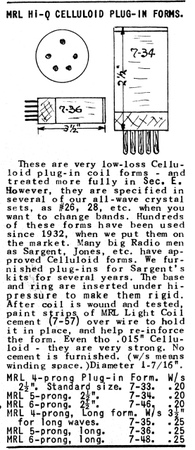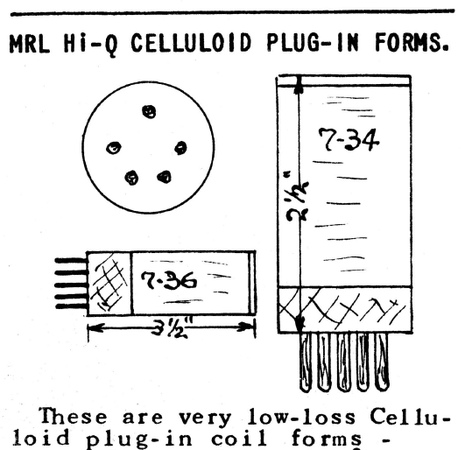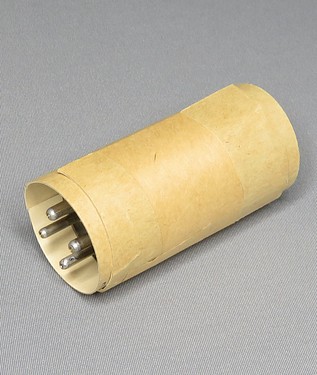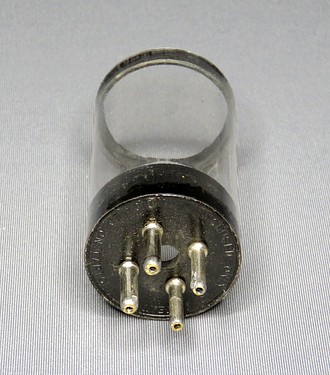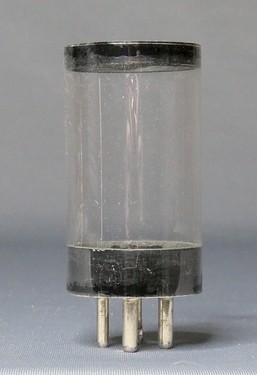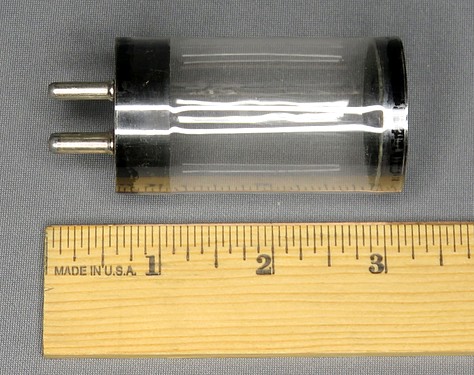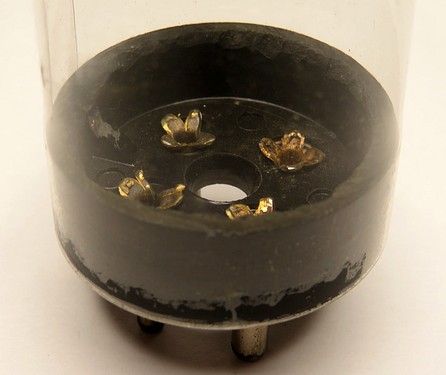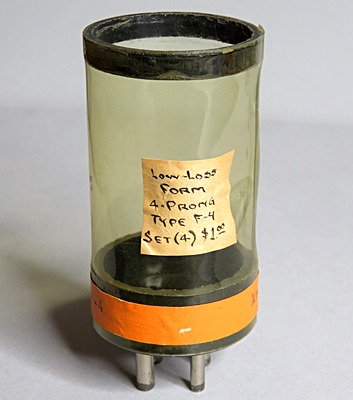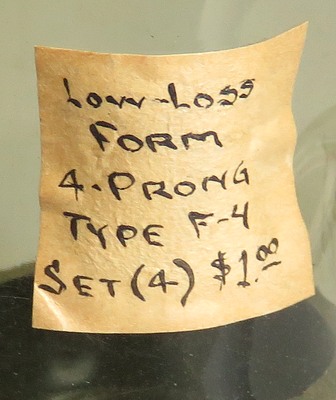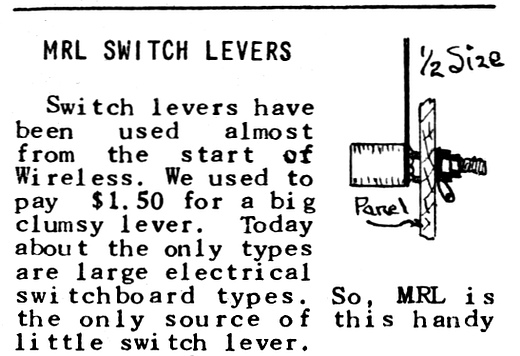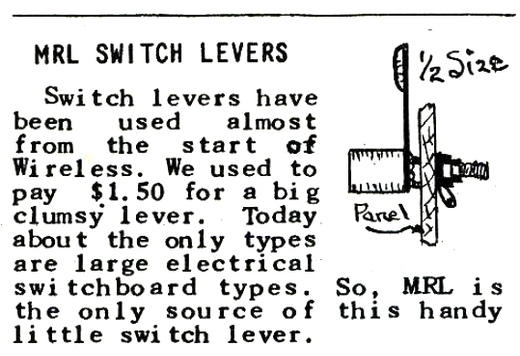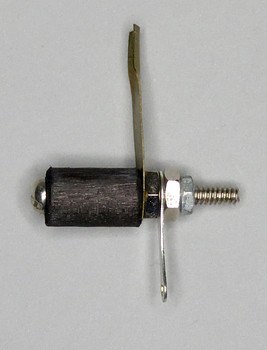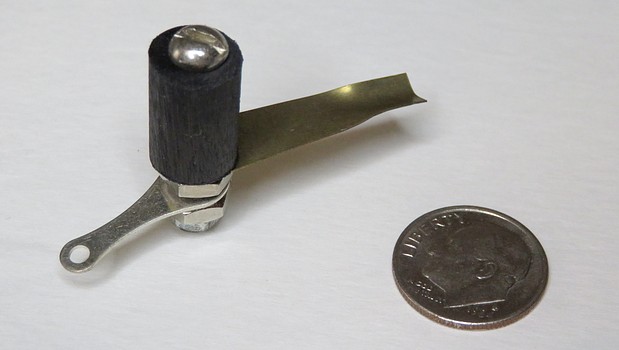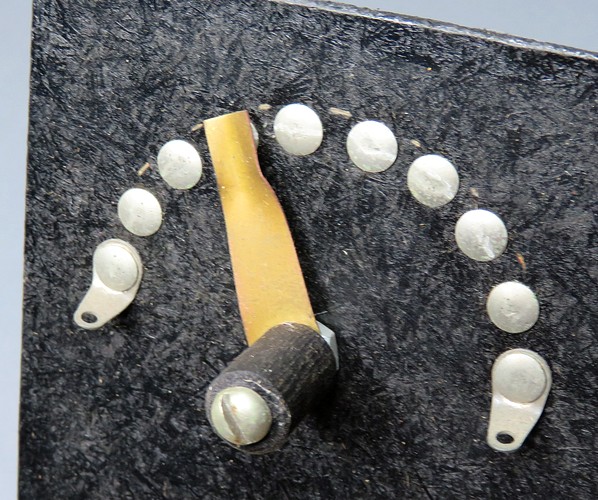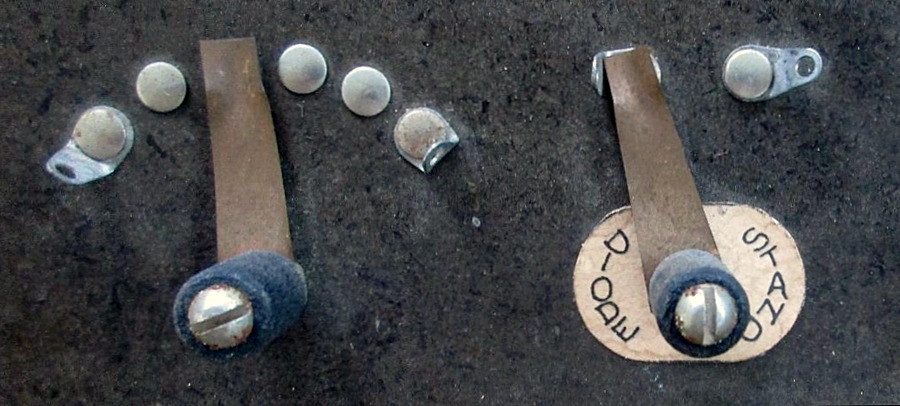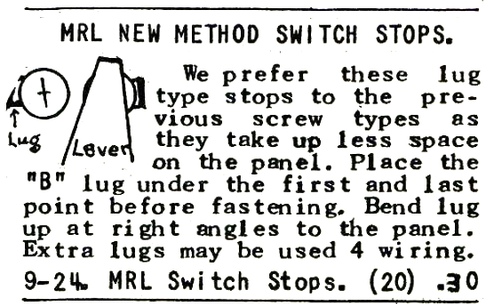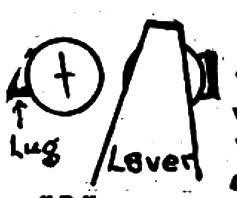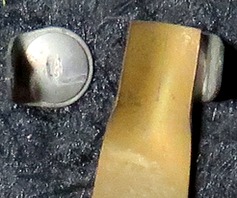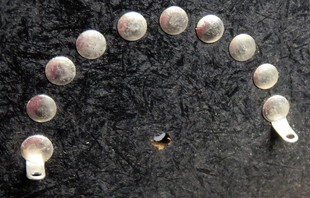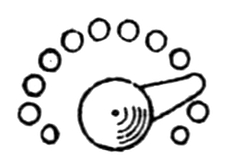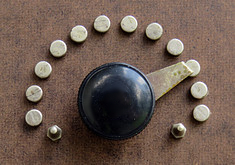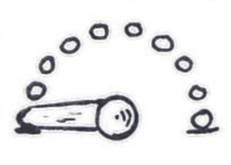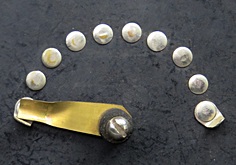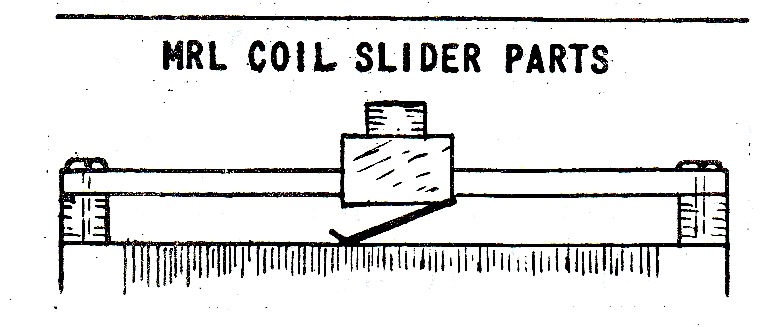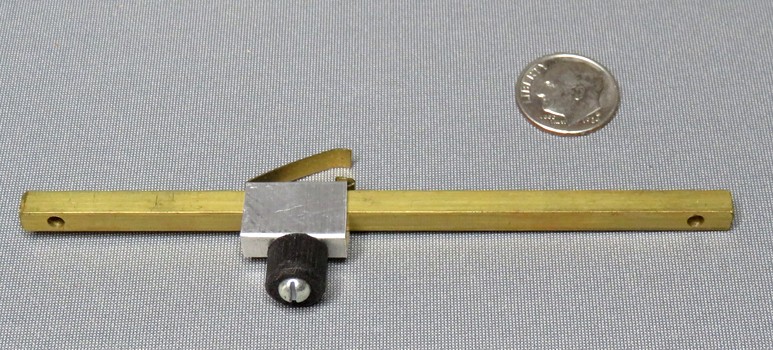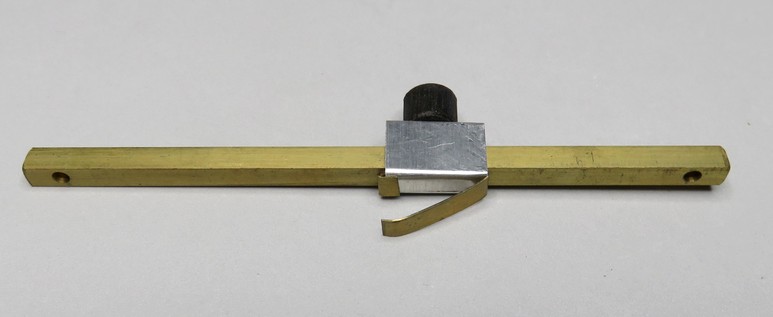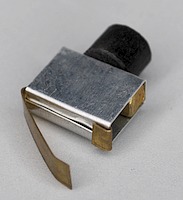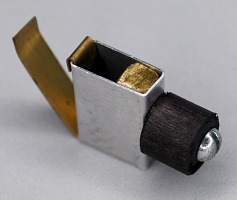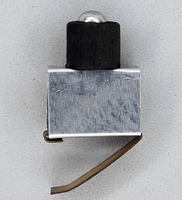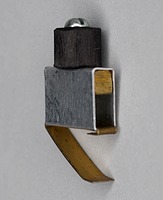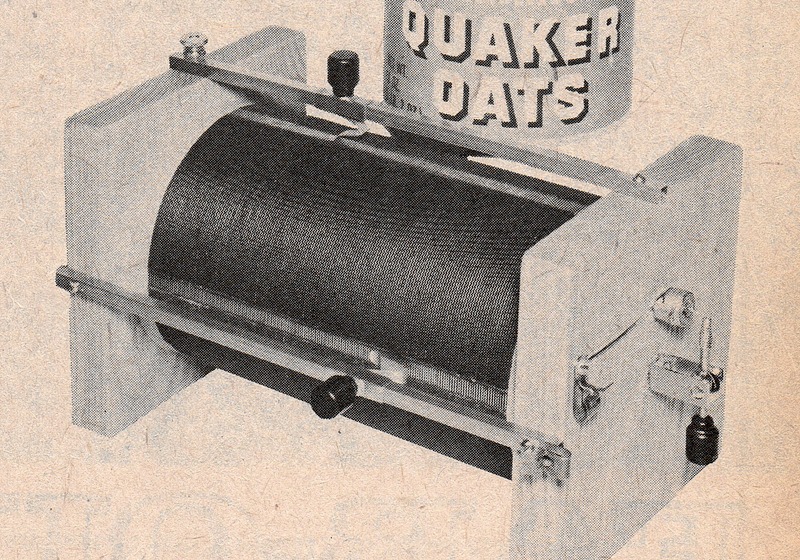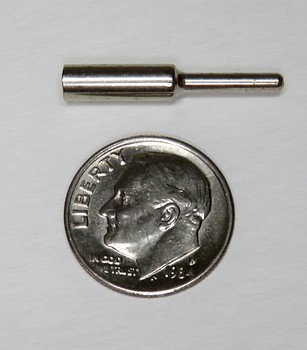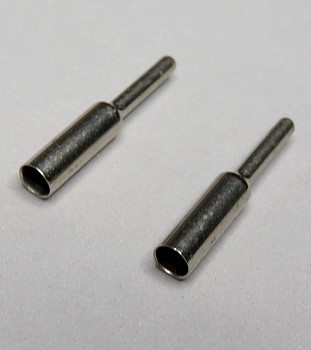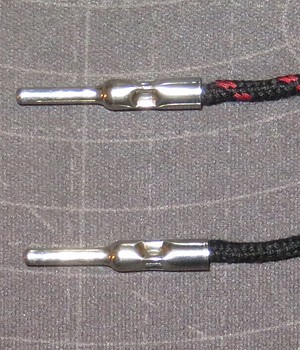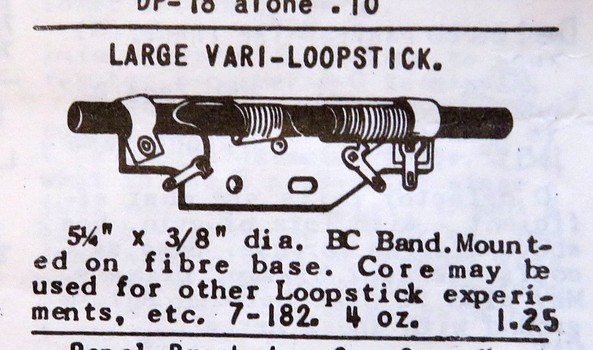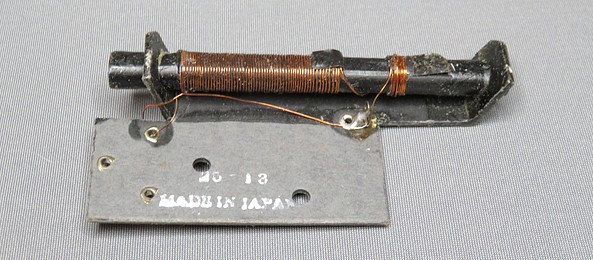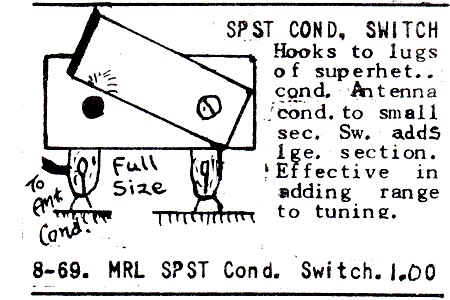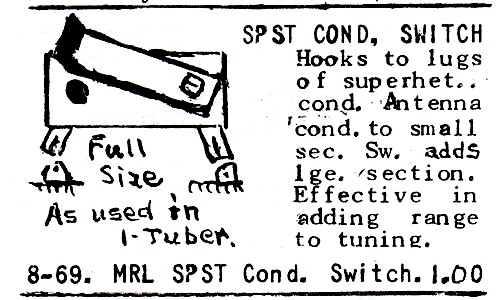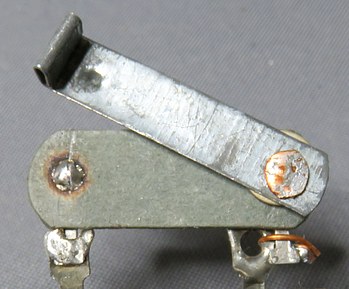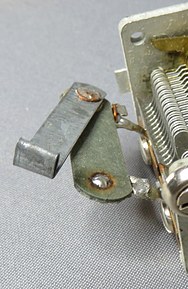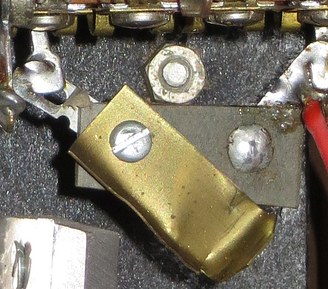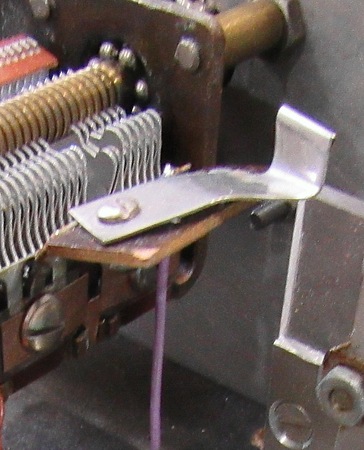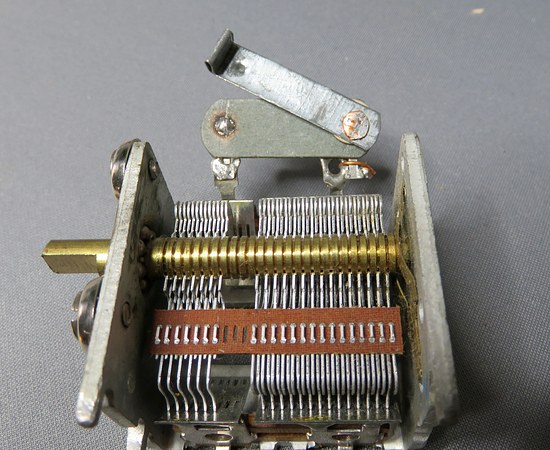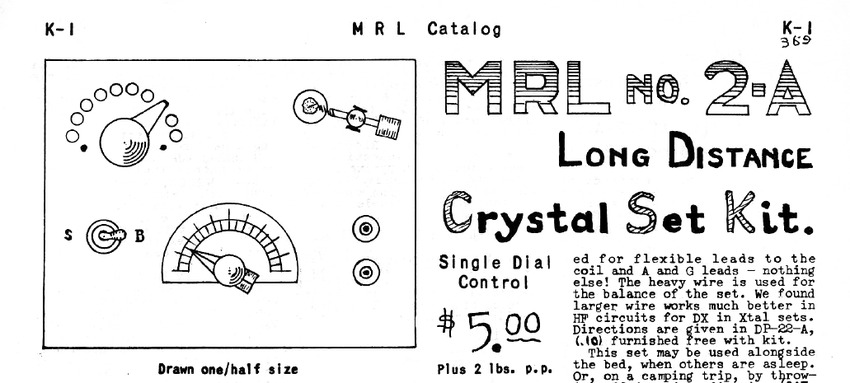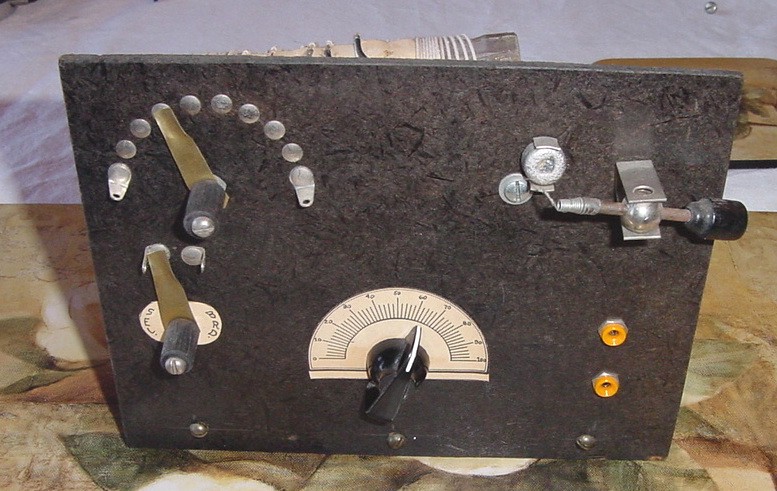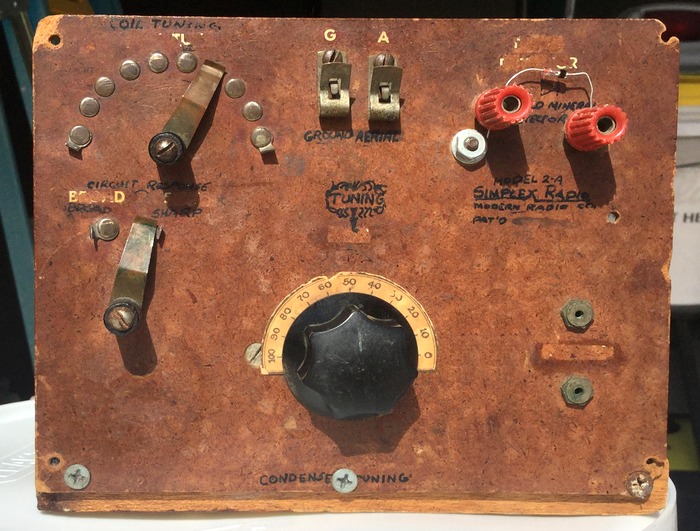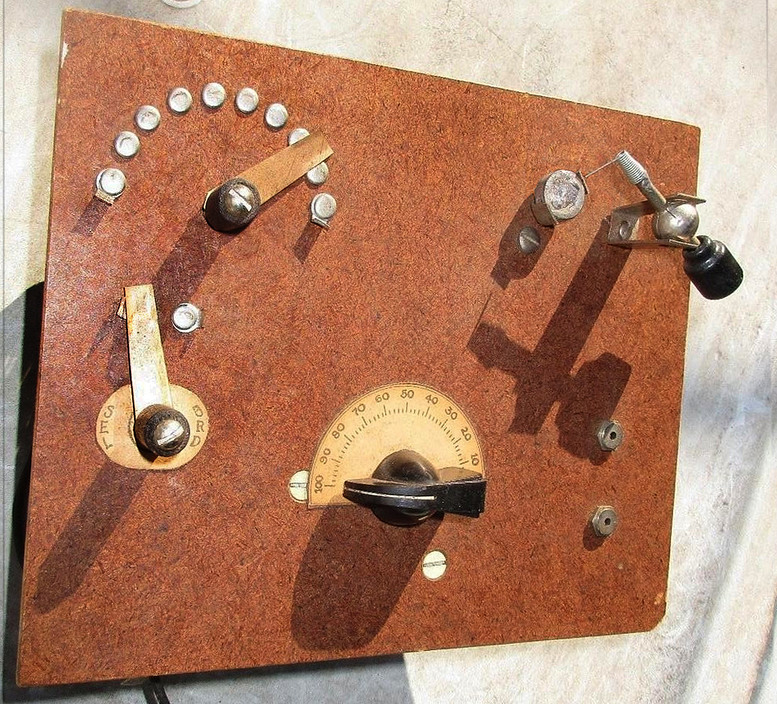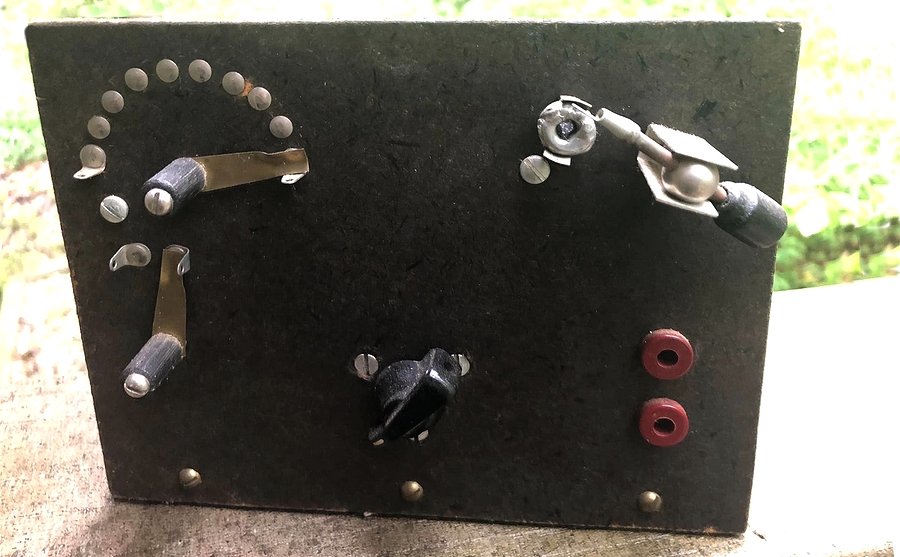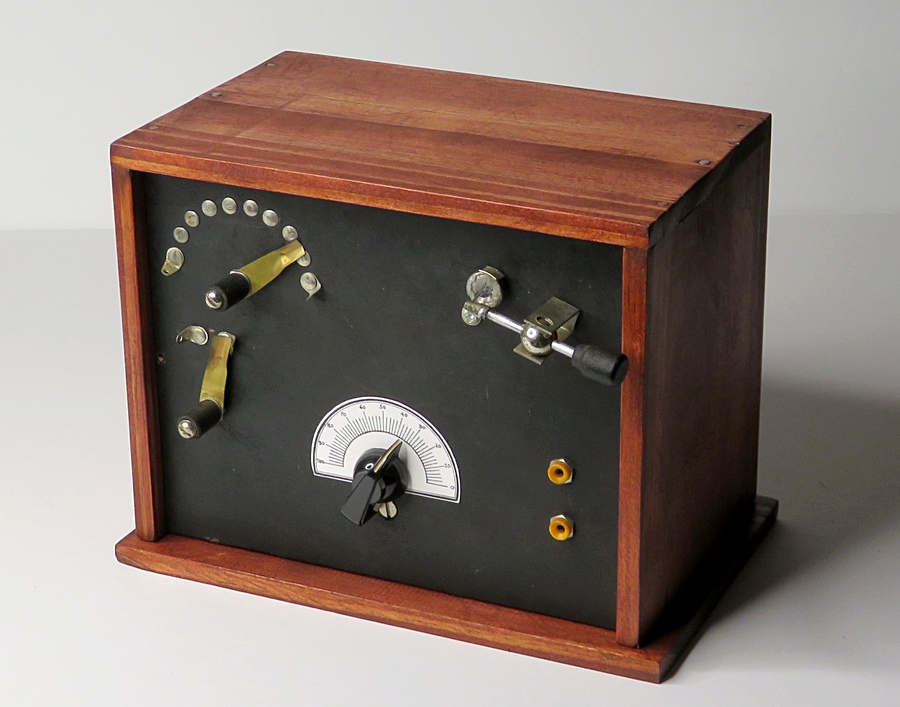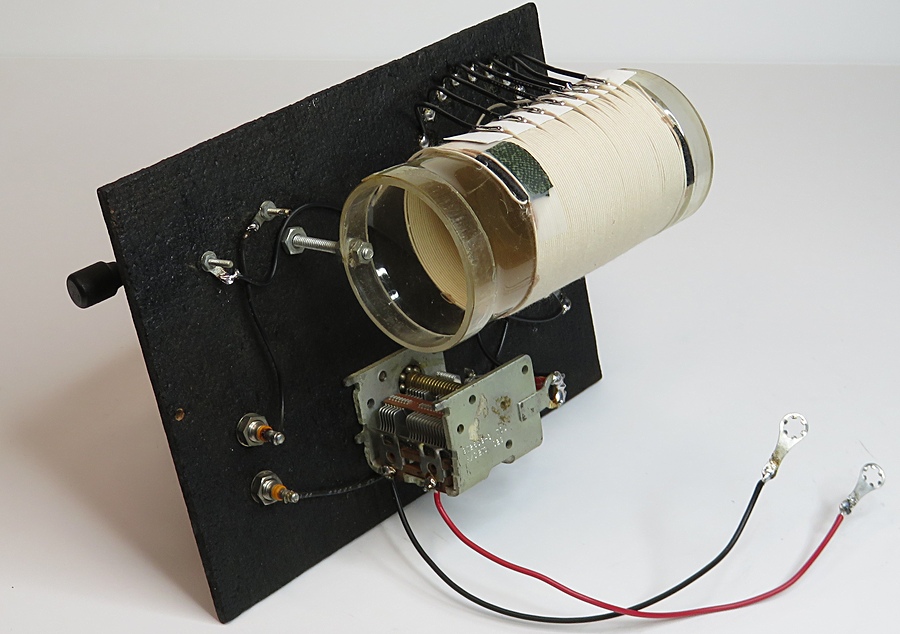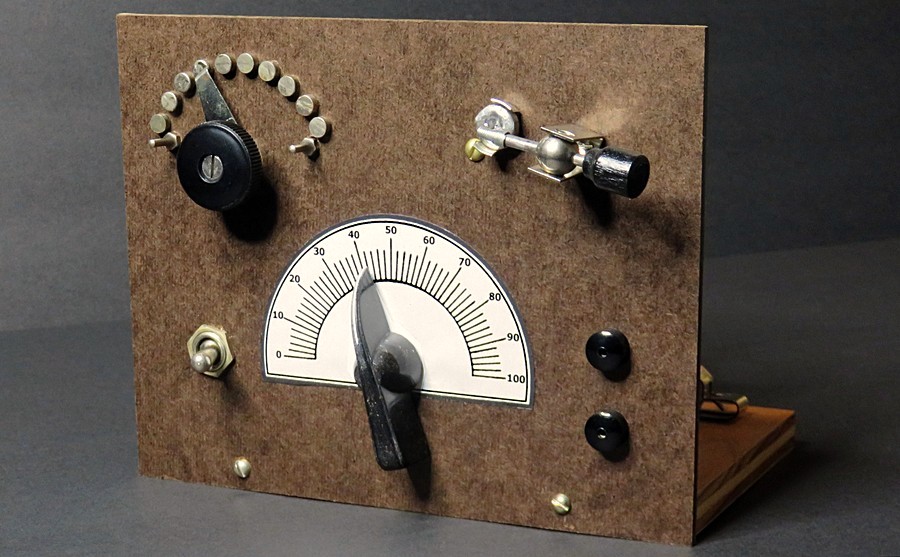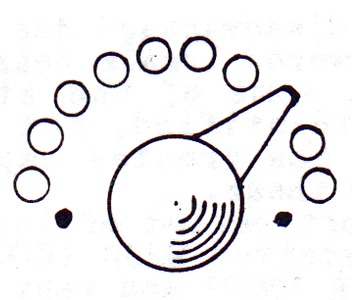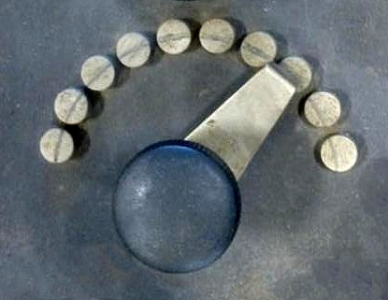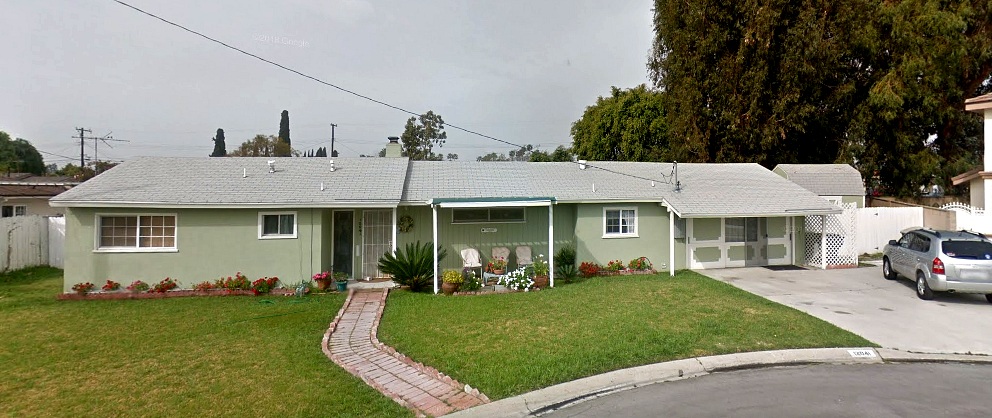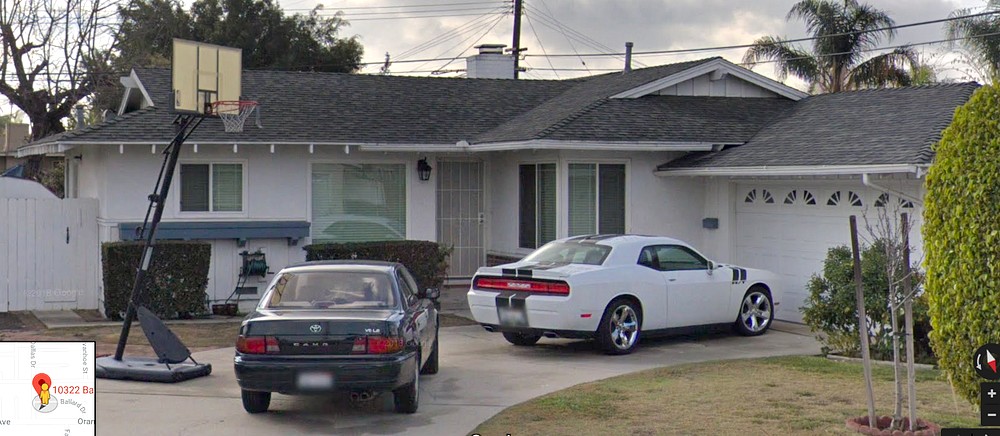|
|
|
|
|
|
MRL CELLULOID COIL FORMS |
|
|
|
From the Modern
Radio Labs catalog, January, 1963. MRL had been a source of
plug-in coil forms for decades after other manufacturers
stopped making them. However, by 1979 this item was no
longer being sold.
|
|
|
|
|
|
|
|
A coil form like this one is what started
MRL. In 1932 Elmer was in his radio shop and ran out of
coils. He rigged up some celluloid forms on tube bases, and
Modern Radio Laboratories was born. Notice a vacuum tube
base has been cut horizontally and the cut part is used as
the top ring.
Forty years later Elmer could no longer obtain tube bases,
so he made the bases himself. Later on this site we'll see
that it once took him an entire day to make one set of six. |
|
|
|
|
| |
|
|
|
|
| |
This form was made between
1934 and 1938. In 1973 they were still the same price, but
the designation "TYPE F-4" was no longer used. Instead, they
were listed as CAT No. 7-33.
A dollar in 1938 was was worth $4.62
in 1978, but in 1978 Elmer was still selling them at the old
price of 25¢ each. Adjusted for inflation, that's 5¢. They
should have been $1.16 each. How did that one slip by him? |
|
|
|
|
|
|
MRL SWITCH LEVERS |
|
|
|
| |
|
|
|
| |
1963 catalog
drawing |
1973 catalog
drawing |
|
|
This catalog item
shows a switch lever. If you had never seen one, could you
tell what it is? Elmer didn't use perspective or draw
anything at an angle. In this case we are looking at it
sideways. The switch lever is mounted to a panel and we can
see both the front (left) and the rear of the lever.
|
|
|
|
|
|
|
|
| The switch
lever in use. It's not just a lever, it's part of
the switch. In this application it is selecting the
taps on the coil of a MRL No. 2 crystal set. If a
rotary switch were used here, the clicking of the
switch would knock the cat whisker off the hot spot
on the crystal. |
|
|
|
|
|
|
Switches from an MRL Number 10 set. |
| |
|
|
MRL NEW METHOD SWITCH STOPS |
|
|
|
|
What are these? What is the drawing showing? |
|
|
|
|
| Switch stops stop your switch! Elmer's
"New Method" stops are just soldering lugs, but they do the
trick. He even wrote "Lug" on the drawing. Elmer "preferred"
this type. In reality, actual switch stops were no longer
made.
|
|
|
|
|
|
When did MRL begin making their own switches? |
|
|
|
|
| Here are excerpts from two drawings of
the MRL No. 2 crystal set. The drawing on the left was
published in 1945. The second drawing was published in 1958.
Even in 1945 these switches had been out of style for
decades. EO had to invent his own switch and switch stops
when his supply ran out. According to Radio Builder No.
34, it was in 1952. |
|
|
|
|
|
MRL COIL SLIDER |
|
|
|
|
|
|
This drawing in the catalog looks pretty much what
the actual slider looks like. |
|
|
|
|
|
|
|
|
|
|
|
|
|
|
|
|
In 1979 the slider
was 25¢,
the rod was 10¢. If you requested it, Elmer would
drill the holes in the rod for 5¢ each.
Elmer provided instructions somewhere in his
documentation to make almost everything he sold. The
slider on the right is made of five different parts.
Do you want to find all the materials and make one
yourself, or just order one from MRL?
Considering what went into the construction of the
slider, 25¢ was a great deal even in 1979!
|
|
|
|
|
|
Crystal radio with two MRL inspired sliders. This
photo is from the March - April 1975 issue of Elementary
Electronics,
page 55. The article was written by Art Trauffer. MRL is
listed as a source for "most of the hardware."
Note: At the time the magazine article was written,
Elmer was 76 years old. In April of 1975 he wrote that he
had been in the hospital for four days to have a polyp
removed. He then went back for another ten days to have part
of his colon removed after cancer had been found.
Upon returning home he had over 150 orders waiting for him,
mostly due to the magazine article. He had to make hundreds
of coil sliders to fill the orders. Some of the orders were
large, over $100. At the same time, Mabel Osterhoudt, who
had had cataract surgery five years before, developed nerve
damage in her right eye. Along with a drooping eyelid, her
right eye would not track with her left eye.
Two months later, 70 of the 150 orders had been filled with
another 80 to go. Elmer included notes with each order
thanking his customers for their "extreme patience and
consideration."
Just as he was catching up with the backlog, the exact same
article was published six months later in the Fall-Winter
editions of Electronics Hobbyist
magazine, then again in the 1976 Spring-Summer edition.
This advertisement appeared in all three
magazines.
Links:
Elementary Electronics 1975 March-April
Electronics Hobbyist 1975 Fall-Winter
Electronics Hobbyist 1976 Spring-Summer |
|
|
|
|
|
PHONE TIP |
|
|
|
|
|
|
What's this, a lint roller? Screwdriver? Should we
order some? They are only 5¢. |
|
|
|
|
|
They are the tips for your headphone cord or anything
else you want to plug into your radio. |
|
|
|
|
LOOPSTICK ANTENNA COIL |
|
|
|
|
|
This drawing was obviously not made by Elmer, but
neither was the coil. The exact same
drawing can be found in old Philmore catalogs. Philmore made
hundreds of radio parts and sets.
|
|
|
Doesn't match the picture but this came from MRL. By
the 1980s this was no longer available.
MRL "DATA SHEETS" Vol 1, pages 2 and 3 show two circuits using this
coil. |
|
|
|
|
MRL CONDENSER SWITCH |
|
|
|
|
1982 drawing |
1986 drawing |
|
|
|
|
|
|
|
|
|
Closing the MRL switch adds a second set of variable
capacitor plates to the circuit. Some builders of the MRL 1 Tube set
put a switch on the front panel for this purpose. Elmer's method
doesn't add any inductance in the form of extra wires. |
|
|
|
| MRL No. 2-A
CRYSTAL SET |
|
| |
|
|
Catalog entry for the MRL No. 2-A
Click on picture for full sized catalog
page. |
| |
|
|
| An actual MRL No. 2-A. |
| |
|
|
Here is a 2-A from 1957, built by Northe
Osbrink. The knob isn't original and the Philmore cat
whisker
detector didn't survive. The Philmore detector cost 20 cents
in 1957. Today it costs 200 times as much, if you can find
one. |
|
|
| |
|
|
| This photo shows a No. 2-A remarkably
similar to the one built by Northe Osbrink in 1957. Same
unpainted front panel, phone jacks and dial scale. |
|
|
| |
|
|
| Another nice example. This one is
owned by Brad Buck, who reported that he picked up this "homebrew
set" but couldn't remember where. |
|
| |
|
|
| This one probably dates back to
the 1970s. Refurbished in 2023. |
|
| |
|
|
| Rear view. |
|
| |
|
|
| A modern reproduction of a 2-A. An
attempt was made to duplicate how it would have looked in 1933.
|
|
| |
|
|
| Why doesn't the switch in the drawing
match the one on the 1957 radio? At one time, it did. Elmer
probably made the drawing of the radio in 1933 and then
used the same drawing for the next 50 years. When he
designed the No.2 and 2-A crystal sets, commercially made
switches were readily available, and that's what you got. |
|
| |
|
| |
|
|
| In 1969 Elmer and Mabel (and MRL)
lived at 12041 Sheridan Lane in Garden Grove, California. |
| |
|
|
| From 1972 till his death in 1986,
Elmer and MRL lived here at 10322 Ballard Drive in Garden Grove,
California. |
| |
While MRL was at this location, Elmer's
niece, Laverne Osterhoudt (daughter of Elmer's brother
Melvin) visited many times with her father. According to
Laverne, Elmer and Mabel worked from 5AM till 11:30AM. They
would then have lunch at noon and take a nap. Because this
schedule never varied, they could only visit in the
afternoon!
MRL was in the garage. In 1978, a solder
named Ron Layton, who had been an MRL fan since he was ten
years old, was stationed in Fort Huachuca, Arizona. He was
sent to a class in California, and along the way he stopped
to see Elmer. In his own words (related 47 years later),
"I remember the whole back wall of
the storage building was floor to ceiling with boxes of junk
& parts in waiting. Its amazing how much he had crammed in
there but he knew where each thing was. The whole place
smelled like the back of an old overheated tube radio. Also
I remember he had a small portable 3" jaw vise mounted to a
table and a small nightstand next to the table. In the vise
was a pair of big Wiss metal shears and on the night stand
was a small cake tin. He had the shears mounted by the
bottom handle so he could hold pieces of sheet metal to cut
out his switch's and other parts. There were some pieces of
brass cut off in the pan. He wrapped the bottom handle of
the shears with masking tape to keep it from slipping or
something. I imagine he held the metal to be cut in one hand
and operated the shears with the other and the parts fell
into the pan. Neat set up, anyway."
Ron bought
one of the "boxes of junk" for $5. He still has some of the
coils, tube sockets, terminal strips, resistors, capacitors,
antenna insulators and even a picture tube brightener that
were all in the box.
The house was sold on May 4, 1988 by Melvin Osterhoudt, who
handled Elmer's estate. Mr. Paul M. Kim paid $99,090 for it.
It is now valued at over $800,000. According to Laverne, Mel
was in the process of retiring and had no desire to continue
Modern Radio Labs. |
| |
|
|
| |
|
|
| |


